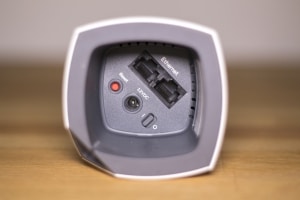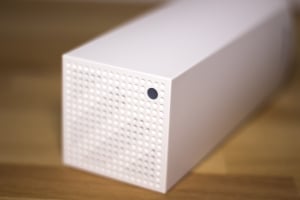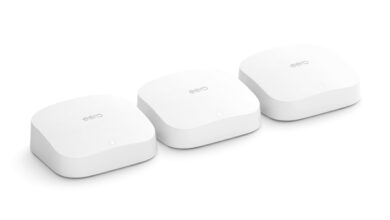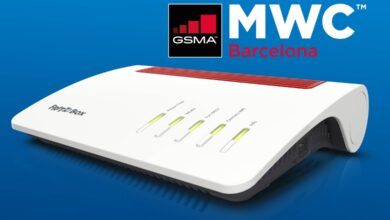
The Linksys Velop Mesh system, which we are going to take a closer look at for you in our current test, is one of the newest and fastest Wi-Fi systems on the market, which is in direct competition with those meshed networks from Google, Netgear and Ubiquiti.
Velop supports users in ensuring complete wireless network coverage in their home environment. The system relies on a unique tri-band connectivity, which is intended to provide one hundred percent signal strength. Signal widths of up to 512 square meters are supported, so that Velop guarantees a perfect Internet connection even in larger environments. However, the Linksys mesh system can only be set up using an app provided especially for this purpose, and not via the in-house PC or laptop.
To find out exactly what the strengths of the Linksys Velop Mesh system are, how easy it is to set up and what features the system offers, please take a look at the test we have provided for you below.
The Hardware
The Velop Mesh system offers multiple ports – including a power port and two Gigabit Ethernet ports. The connectors are located on the underside of the nodes. Therefore the cables are led out at a corner and do not attract attention. The connection with the modem must be established via one of the Ethernet ports, but only at the first node. The other ports can be used freely for the connection of further devices. There is also an LED at the top that lights up in different colors – either constant or flashing, depending on the connection status of the hardware.
The hardware of the Velop Mesh system comes with the tri-band network 802.11ac and the MU-MIMO technology. Two of the units transmit at 867 MBit/s in the 5 GHz range, one of which acts as a backhaul. There is also a 2.4 GHz band with 400 Mbps. The speed is quite low if you compare it with the FRITZ!7590 box, which offers up to 1,733 MBit/s in the 5-GHz band and up to 800 MBit/s in the 2.4-GHz band. However, Linksys Velop is less about speed than a generally good availability.
The Institution
Setting up the Linksys Velop Mesh system is extremely simple, as each individual installation step is explained in the app. You can see the exact procedure in the picture gallery.
The Linksys Velop Mesh system works both in combination with a modem and an upstream router. To set up your Mesh System, you need a user account, which has to be created online, with which you can access the Mesh System from anywhere via the Internet.
There is a Bluetooth LE function that is intended for configuration via the app. This feature works absolutely smoothly in our test. However, according to the English technology website Ars Technica, connection problems can occur with pure modems. For example, the error message “Connection not recognized” appears again and again in the Linksys app for affected users. In this case this problem can only be solved by manually deactivating the mobile data on your mobile phone. However, this problem does not affect all modems Velop is connected to.
Unfortunately, each node has to be added individually, which makes the installation very lengthy. Especially if they still need updates.
The app is very well designed in itself, offers a lot of options and a lot of tips to help you benefit from an ultra-fast WLAN signal. You can define the WLAN access data during setup.
The Functions
The app of the mesh system has numerous functions to offer. Worth mentioning are the push notifications, which are sent directly to your smartphone if you lose your connection. A child protection function allows you to create a usage schedule for each device or to block specific pages that contain content that is harmful to minors or inappropriate. The app also offers a device prioritization function and various forwarding options. These include port forwarding and port range forwarding as well as port range triggering. Not to forget the WLAN MAC filter. This will provide you with an increased level of security when approving additional devices that wish to join your network.
There is also a speed test function that measures both the upload and the download speed. So you always know exactly how fast you are on the net and whether your hardware is set up optimally. The speed is influenced by various factors, such as the number of connected devices, but also by the external signal. Therefore, this function is primarily used to correct errors that have a negative effect on the speed.
In addition, the Linksys Velop Mesh system offers Alexa integration, but with some questionable features. For example, the guest WLAN can be activated by voice command. The login data of the main WLAN can also be queried via Alexa. This means that your password will simply be passed on. Neighbors and unauthorized persons can easily access your password by simply asking Alexa. Therefore you should definitely disable this function. How Linksys will fix this bug in future updates remains unclear.
When using the app via the Vodafone mobile network, I unfortunately encountered problems. So I couldn’t log in to the app at times, the cloud service was supposedly not available. When switching to the local WLAN, however, this worked without any problems. I was also logged out of the app by chance after a short time.
New Update: The Linksys Velop Mesh System gets a web interface
At the end of our test, Linksys released an update that finally makes the mesh system manageable from the browser. This is available both locally and via the Internet. The following additional features are available via the browser interface:
- DHCP server access for automatic assignment of IP addresses to devices newly added to the network. This makes it easier to connect to mobile devices that are often removed from the network and added back later.
- DNS configuration for linking host names, e.g. assigning a Web address to a specific IP address.
- troubleshooting: device table, router report, ping/trace route, protocols. These features provide additional insight into network performance.
- Security: Firewall, VPN passthrough, DMZ settings. Users can use these settings for network security management.
Our Conclusion on the Linksys Velop Mesh System
The setup is very straightforward, even though there may seem to be problems with some constellations – we didn’t have any. The app makes a very clear impression and offers all the necessary functions that a router needs. But there is also criticism: The Alexa function follows the current trend, but unfortunately is not necessarily characterized by comfort and safety. In addition, the individual nodes unfortunately do not provide a USB port for sharing storage media or printers. Likewise, there are no statistics on consumption. Linksys has now eradicated the biggest point of criticism: there is now a web interface for the browser.
Nevertheless, it is sufficient for a good test rating for the Velop Mesh system, not least because of the significantly better Internet connection for all network participants who are further away from the main node.
Linksys Velop
Setup
User Interface
Features
Price-Performance Ratio
More range for WLAN!
With the Linksys Velop mesh system, the WLAN range can easily be improved. Unfortunately, the system does without important ports such as USB.















































































































